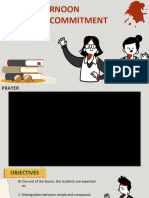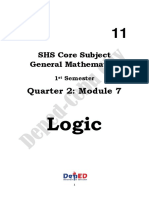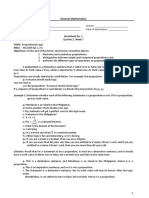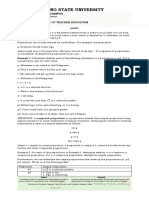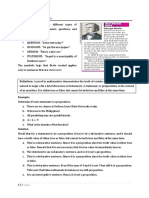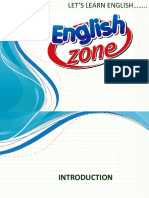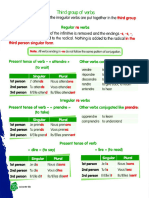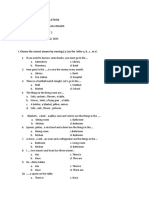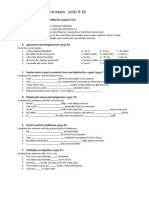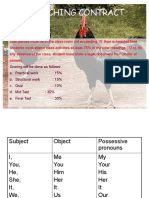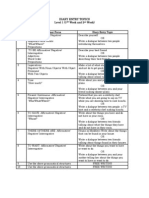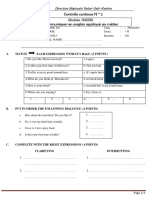General Mathematics
Quarter 2 - Module 7
Propositions and Symbols
SDO_SC_Q2_GenMath11_SLM7of9
�This Self-Learning Module (SLM) was designed and written with you in mind to help you
master Propositions and Symbols. The scope of this learning material focuses on many
different learning situations. Moreover, the language used recognizes the diverse vocabulary
level of learners and the lessons are arranged following the standard sequence of the
course. Hence, the order in which you read them can be changed to correspond with the
textbook you are now using.
The SLM contains:
Lesson 7: Propositions and Symbols
It is divided into two sub-lessons, namely:
Lesson 7.1: Simple and Compound Propositions
Lesson 7.2: Operations on Propositions
After going through this SLM, you are expected to:
1. illustrate propositions;
2. symbolize propositions;
3. distinguish between simple and compound propositions; and
4. perform the different types of operations on propositions.
2 SDO_SC_Q2_GenMath11_SLM7of9
� Pretest
Directions: Read each item carefully and critically. Choose the letter of the correct answer
and write your answers on a separate sheet of paper.
1. Which of the following statements is an example of a proposition?
A. God bless you!
B. What is the time now?
C. The only odd prime number is 2.
D. Get me a glass of pineapple juice.
2. What does q → p implies if p: I am in Surigao and q: I love cricket?
A. I love cricket.
B. I am not in Surigao.
C. If I love cricket, then I am in Surigao.
D. If I am in Surigao, then I love cricket.
3. Which of the following connectives is usually used in a conjunction proposition?
A. or B. not C. and D. if…then
4. Which of the following is the symbol for conjunction proposition?
A. q → p B. p ∧ q C. p v q D. ~ p
5. Which of the following choices does NOT use a logical connective?
A. Negation C. Conjunction
B. Statement D. Biconditional
6. What is the result with the thought or meaning of a disjunction proposition, when one
of its statements is false?
A. True C. Negated
B. False D. Both True and False
7. It refers to the statement between if and then in a conditional statement.
A. Disjunct C. Antecedent
B. Predicate D. Consequent
8. Which of the following is true?
A. ~ p is false when p is true, and ~ p is true when p is true.
B. p→ q is true only when p is true and q is false; otherwise, it is true.
C. The disjunction p ∨ q is false only when both disjuncts p and q are true.
D. The conjunction p ∧ q is true when p and q are both true; otherwise, the
conjunction is false.
3 SDO_SC_Q2_GenMath11_SLM7of9
� 9. Which of the following statements is an example of a negation proposition?
A. Humans are mortal.
B. It is not the case that I love milk.
C. I like chocolate drink if and only if I like tea.
D. If I travel by bus, then my trip will be cheaper.
10. What is the symbol for a biconditional proposition?
A. ~ B. ↔ C. ∨ D. →
11. Which of the following statements is an example of a simple proposition?
A. Pause for a while.
B. When in doubt, stop!
C. If it is an angle, then it is an acute angle.
D. A quart of juice weighs less than 8 ounces.
12. What type of proposition conveys one thought without connectives?
A. Antecedent
B. Consequent
C. Simple proposition
D. Compound Proposition
13. Which of the following is the symbolic statement of the proposition “Robin can swim
or Tom plays the guitar.”?
A. ~ (p ∧ q) B. ~ (p ∨ q) C. p ∨ q D. p ∧ ~ q
14. Which of the following statements describes a conjunction proposition?
A. Has two conditional statements.
B. Has antecedent and consequent statements.
C. Two simple propositions connected using the word “and”.
D. Obtained by inserting the word not in the given statement.
15. Which of the following choices is the symbol for a conditional proposition?
A. q → p B. p ∧ q C. p v q D. ~ p
4 SDO_SC_Q2_GenMath11_SLM7of9
� Propositions and Symbols
Proposition is a declarative sentence that can be classified as true or false, but not both. If
a proposition is true, then its truth value is true which is denoted by T; otherwise, its truth
value is false and is denoted by F.
Remark that propositions are usually denoted by small letters as shown in the next example.
For example,
p: Everyone should study logic.
may be read as
p is the proposition “Everyone should study logic.”
If a sequence of propositions is considered, we denote the propositions by p1, p2, …
Example 1. Determine whether each of the following statements is a proposition or not. If
proposition, give its truth value.
p: Mindanao is an island in the Philippines.
q: Find a number which divides your age.
r: How old are you?
s: The number 4 is even and less than 12.
t: 3 + 2 = 5
u: 𝑥 + 3 = 10
Solution.
Recall that for a statement to be a proposition it has to be a declarative sentence, and it
should have a truth value of either true or false, but not both true and false at the same time.
p. This is a declarative sentence, and Mindanao is an island in the Philippines. Hence,
p is a true proposition.
q. This is an imperative sentence, and so it is not a proposition.
r. This is an interrogative sentence, and so it is not a proposition.
s. This is a declarative sentence, and number 4 is even and less than 12. Hence, s is a
true proposition.
t. Obviously, 3 + 2 = 5 is a true mathematical sentence. But, is it a declarative
sentence? Yes! To see this, note that you may read it as “The sum of three and two is
five,” which is clearly a declarative sentence. Therefore, t is a true proposition.
u. This is not a proposition since its truthfulness is dependent on the value of x.
5 SDO_SC_Q2_GenMath11_SLM7of9
�Lesson 7.1. Simple and Compound Propositions
Definition
Simple proposition is a proposition that conveys one thought with no connecting
words.
Compound proposition is a proposition that contains two or more simple
propositions that are put together using connective words.
From the propositions in example # 1, which of the following are simple propositions?
Solution: The following are simple propositions.
p: Mindanao is an island in the Philippines.
t: 3 + 2 = 5
The following are examples of compound propositions.
p1: It is not a case that 2 is a rational number.
p2: Either logic is fun and interesting, or it is boring.
p3: If you study hard, then you will get good grades.
p4: If you are more than 60 years old, then you are entitled to a Senior Citizen’s card,
and if you are entitled to a Senior Citizen’s card, then you are more than 60 years old.
Compound propositions above can be broken into simple propositions that make up p1, p2,
p3, and p4.
Propositions Simple Components
p1 a: 2 is a rational number
p2 b: Logic is fun.
c: Logic is interesting.
d: Logic is boring.
p3 e: You study hard.
f: you get good grades.
p4 g: You are more than 60 years old.
h: You are entitled to a senior citizen’s card.
6 SDO_SC_Q2_GenMath11_SLM7of9
�Compound propositions can be created using logical connectives or operators.
a) Conjunction (p and q) - Two simple propositions connected using the word
“and”. Sometimes, the word “but” will be used in place
of and in a given sentence.
b) Disjunction (p or q) - Two simple propositions that are connected using the
word “or”.
c) Negation (not p) - The negation of a given statement is a statement that
is false whenever the given statement is true, and true
whenever the given statement is false. The negation
can be obtained by inserting the word not in the given
statement or by prefixing it with phrases such as “It is
not the case that…”
d) Disjunction (if p then q) - Two simple propositions that are connected using the
words if… then. The statement between the if and
then is called the antecedent of the conditional. The
sentence that follows then is called the consequent.
e) Biconditional or Double - Conjunction of two conditional statements where the
Implication (if and only) antecedent and consequent of the first statement
have been switched in the second statement.
Example 2. Using the statements below, make a compound proposition using logical
connectors.
p: I travel by train.
q: My trip will be cheaper.
Solution.
Conjunction: I travel by train and my trip will be cheaper.
Disjunction: I travel by train or my trip will be cheaper.
Negation: I will not travel by train.
Conditional: If I travel by train, then my trip will be cheaper.
antecedent consequent
Biconditional: I travel by train, if and only if my trip will be cheaper.
7 SDO_SC_Q2_GenMath11_SLM7of9
�Lesson 7.2. Operations on Propositions
Symbols are used to simplify work in logic. If x and y are frequently used letter in algebra,
the letters p, q, or r are often used to represent propositions in logic. Below show the several
symbols for connectives, together with the respective types of compound proposition.
a. Conjunction
Connective Symbol
and ∧
Example 3.
p: This book is interesting.
q: I am staying at home
p ∧ q: This book is interesting and I am staying at home.
Truth Table:
p q p∧q
T T T
T F F
F T F
F F F
The conjunction p ∧ q is true when p and q are both true; otherwise, the conjunction is false.
b. Disjunction
Connective Symbol
or ∨
Example 4.
p: This book is interesting.
q: I am staying at home.
p ∨ q: This book is interesting or I am staying at home.
Truth Table:
p q p∨q
T T T
T F T
F T T
F F F
The disjunction p ∨ q is false only when both disjuncts p and q are false.
8 SDO_SC_Q2_GenMath11_SLM7of9
�Note that ‘or’ has several meanings in ordinary language. In our case, we use what
mathematicians call the inclusive or. That is, ‘p ∨ q’ means that p is true or q is true or
BOTH are true.
c. Negation
Connective Symbol
not ~
Example 5.
p: This book is interesting.
~p can be read as:
(i.) This book is not interesting.
(ii.) This book is uninteresting.
(iii.) It is not the case that this book is interesting.
Truth Table:
p ~p
T F
F T
~ p is false when p is true, and ~ p is true when p is false.
d. Conditional
Connective Symbol
if… then →
Example 6.
p: This book is interesting. q: I am staying at home.
p → q: If this book is interesting, then I am staying at home
Truth Table:
p q p→ q
T T T
T F F
F T T
F F T
p→ q is false only when p is true and q is false; otherwise, it is true.
9 SDO_SC_Q2_GenMath11_SLM7of9
� e. Biconditional
Connective Symbol
if and only if ↔
Example 6:
p: This book is interesting.
q: I am staying at home.
p ↔ q: This book is interesting if and only if I am staying at home.
Truth Table:
p q p↔q
T T T
T F F
F T F
F F T
p ↔ q is true when and only when p and q have the same truth value.
Application:
Suppose that Geebee is a Grade 11 student. Consider the following conditionals:
p1: If Geebee is in Grade 11, then she is a senior high school student.
p2: If Geebee is in Grade 11, then she is working as a lawyer.
p3: If Geebee has a degree in Computer Science, then she believes in true love.
Analyze the truth values of these conditionals.
Solution.
p1: ‘Geebee is in Grade11’ and ‘Geebee is a senior high school student’ are both
true. Since the hypothesis and conclusion are both true, then p1 is true.
p2: ‘Geebee is in Grade 11’ is true and ‘Geebee is working as a lawyer’ is false
because a Grade 11 student is not yet qualified to be a lawyer. Since the hypothesis is
true but the conclusion is false, the p2 is false.
p3: ‘Geebee has a degree in Computer Science’ is false because Geebee is still
in Grade 11, and so cannot possibly have a university degree yet. On the other hand, we
do not know the truth value of ‘Geebee believes in true love’. However, p3 is true
regardless of truth value of its conclusion.
10 SDO_SC_Q2_GenMath11_SLM7of9
�General Directions: Work on Activities 1-4 that follow. Do it on a separate sheet of
paper.
Activity 1: Proposition or Not
Directions: Analyze the statements below. Write the word Proposition if it is a proposition
and Not Proposition if it is not.
1. The moon is a star.
2. Why are you upset?
3. √2 is rational.
4. Do not disturb.
5. 𝑋 2 − 4 + 0, 𝑤ℎ𝑒𝑛 𝑋 = 2
6. Every counting number is a whole number.
7. It is red in color.
8. Every square is a rectangle.
9. If you are good in Math, then you are not good at English.
10. What a horrible sight it was!
Activity 2: Classifying Proposition
Directions: Classify the following statements as Simple Proposition, Compound Proposition
or Neither. If it is a compound, state the simple component that composes the
compound proposition.
1. Today is Sunday.
2. You may avail of the 50% discount if and only if you are a member of the team.
3. Both Kim and Dexie are top contenders for the Employee of the Month.
4. Roy went hunting or mountain climbing.
5. Neither Erica nor Amy is present.
Activity 3: Writing Symbols
Directions: Transpose the following propositions into symbols using the given propositions
below.
Let r: I like strawberry drink.
s: I like milk tea.
1. If I like strawberry drink, then I like milk tea.
2. I like milk tea or strawberry drink.
11 SDO_SC_Q2_GenMath11_SLM7of9
� 3. I do not like strawberry drink but I like milk tea.
4. If I like strawberry drink, then I dislike milk tea.
5. I dislike both strawberry drink and milk tea.
Activity 4: From Symbols to Statements
Directions: Transpose the following symbols into verbal forms or propositions using the
statements below.
p: The streets are flooded
q: There is a heavy traffic
1. p∨q
2. p ∧~ q
3. ~ (p ∨ q)
4. ~ (p ∧ q)
5. ~ (p → q)
12 SDO_SC_Q2_GenMath11_SLM7of9
�Directions: Complete the 3-2-1 Chart about your discoveries in Propositions and Symbols.
Write your answers on a separate sheet of paper.
13 SDO_SC_Q2_GenMath11_SLM7of9
� Posttest
Directions: Read and analyze each item carefully. Write the letter of the correct answer on
a separate sheet of paper.
1. Which of the following choices is the symbol for a conditional proposition?
A. q → p B. p ∧ q C. p v q D. ~ p
2. Which of the following is the symbolic statement of the proposition “Robin can swim or
Tom plays the guitar.”?
A. ~ (p ∧ q) B. ~ (p ∨ q) C. p ∨ q D. p ∧ ~ q
3. Which of the following statements is an example of a simple proposition?
A. Pause for a while.
B. When in doubt, stop!
C. A quart of juice weighs less than 8 ounces.
D. If it is an acute angle, then it is an acute angle.
4. Which of the following statements is an example of negation proposition?
A. Humans are mortal.
B. It is not the case that I love milk.
C. I like chocolate drink if and only if I like tea.
D. If I travel by bus, then my trip will be cheaper.
5. It refers to the statement between if and then in a conditional proposition?
A. Disjunct C. Antecedent
B. Predicate D. Consequent
6. Which of the following choices does NOT use a logical connective?
A. Negation C. Conjunction
B. Statement D. Biconditional
7. Which of the following connectives is usually used in conjunction proposition?
A. or B. not C. and D. if…then
8. Which of the following statements is an example of a proposition?
A. God bless you!
B. What is the time now?
C. The only odd prime number is 2.
D. Get me a glass of pineapple juice.
9. What does q → p implies if p: I am in Surigao and q: I love cricket?
A. I love cricket.
B. I am not in Surigao.
C. If I love cricket, then I am in Surigao.
D. If I am in Surigao, then I love cricket.
10. Which of the following is the symbol of a conjunction proposition?
A. q → p B. p ∧ q C. p v q D. ~ p
14 SDO_SC_Q2_GenMath11_SLM7of9
�11. What is the result with the thought or meaning of a disjunction proposition, when one
of its statements is false?
A. True C. Negated
B. False D. Both True and False
12. Which of the following statements is true?
A. ~ p is false when p is true, and ~ p is true when p is true.
B. p→ q is true only when p is true and q is false; otherwise, it is true.
C. The disjunction p ∨ q is false only when both disjuncts p and q are true.
D. The conjunction p ∧ q is true when p and q are both true; otherwise, the
conjunction is false.
13. What is the symbol of a biconditional proposition?
A. ~ B. ↔ C. ∨ D. →
14. What type of proposition conveys one thought with no connecting words?
A. Antecedent
B. Consequent
C. Simple proposition
D. Compound Proposition
15. Which of the following statements describes a conjunction proposition?
A. It has two conditional statements.
B. It has an antecedent and consequent statements.
C. It is formed by inserting the word “not” in the given statement.
D. It is composed of two simple propositions connected using the word “and”.
15 SDO_SC_Q2_GenMath11_SLM7of9
�SDO_SC_Q2_GenMath11_SLM7of9 16
Activity 1 Activity 2
1. Proposition 1. Simple Proposition
Pretest 2. Not a Proposition 2. Compound Proposition
3. Proposition 3. Compound Proposition
1. C 4. Not a Proposition 4. Compound Proposition
2. C 11. D 5. Proposition 5. Compound Proposition
3. C 12. C 6. Proposition
4. B 13. D 7. Proposition
5. B 14. C 8. Proposition
6. A 15. A 9. Proposition Activity 3
7. C 10. Not a Proposition 1. r → s
8. D
2. s ∨ r
9. A
10. B 3. ~ r ∧ s
4. r → ~ s
5. ~ (r ∧ s)
Activity 4
1. The streets are flooded or there is a heavy traffic.
2. The streets are flooded and there is no heavy traffic.
3. The streets are not flooded or there is no heavy traffic.
4. The streets are not flooded and there is no heavy traffic.
5. If the streets are not flooded, then there is no heavy traffic.
Posttest
Reflection 1. A 6. B 11. A
2. C 7. C 12. D
Learners answers may Vary
3. C 8. C 13. B
4. B 9. C 14. C
5. C 10. B 15. D
Answer Key
�Books:
Banigon, R. J. (2019). General Mathematics for Senior High School Revised Edition. Quezon City: Educational
Resources Corporation.
Crisologo, L. A. (2016). Teaching Guide for Senior High School General Mathematics Core Subject. Quezon City:
Commission on Higher Education.
Oronce, O. A. (2016). General Mathematics. Quezon City: Rex Printing Company, Inc.
Online:
Truth Tables, Tautologies, and Logical Equivalences. Accessed November 4, 2020.
https://sites.millersville.edu/bikenaga/math-proof/truth-tables/truth-tables.html.
“Department of Mathematics.” MAD 2104 COURSE NOTES. Accessed November 4, 2020.
https://www.math.fsu.edu/~pkirby/mad2104/index.math.htm.
“Propositions - Discrete Mathematics Questions and Answers.” Sanfoundry, June 1, 2020.
https://www.sanfoundry.com/discrete-mathematics-questions-answers-propositions/.
General Mathematics
Self-Learning Module (SLM)
Quarter 2 – Week 7: Propositions and Symbols
Second Edition, 2022
Published by the Department of Education, Caraga Region
Schools Division Office of Surigao City
Schools Division Superintendent: Karen L. Galanida
Assistant Schools Division Superintendent: Florence E. Almaden, Laila F. Danaque
Development Team of the Self- Learning Module (SLM)
Writer : Desire A. Paorco
Editor : Roxan G. Laodenio
Evaluators : Noemi D. Lim, Rufina Creencia, John Benedict B. Entrada
Management Team : Karen L. Galanida
Florence E. Almaden, Laila F. Danaque
Carlo P. Tantoy
Elizabeth S. Larase
Noemi D. Lim
Printed in the Philippines by the Schools Division Office of Surigao City
Office Address : M. Ortiz Street, Barangay Washington
: Surigao City, Surigao del Norte, Philippine
Telephone : (086) 826-1268; (086) 826-3075; (086) 826-8931
E-mail Address : surigao.city@deped.gov.ph
SDO_SC_Q2_GenMath11_SLM7of9


